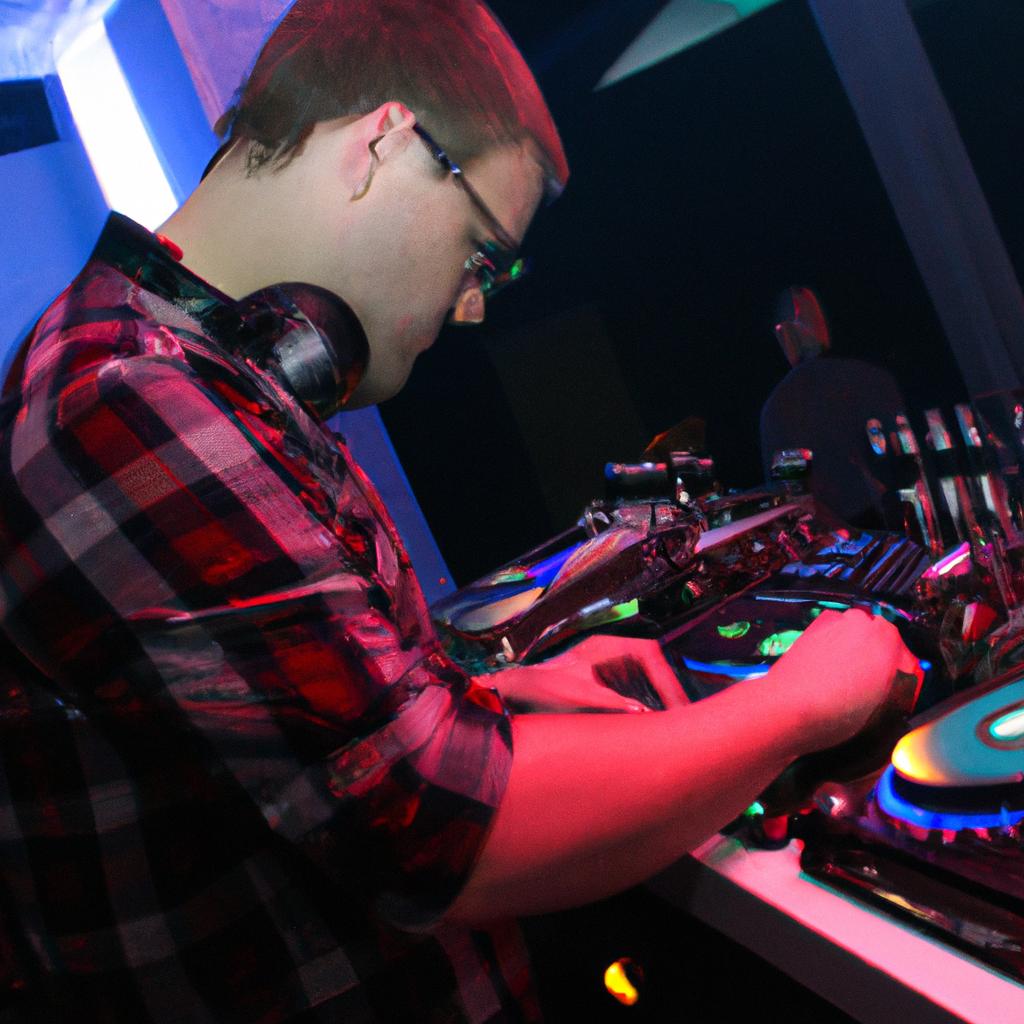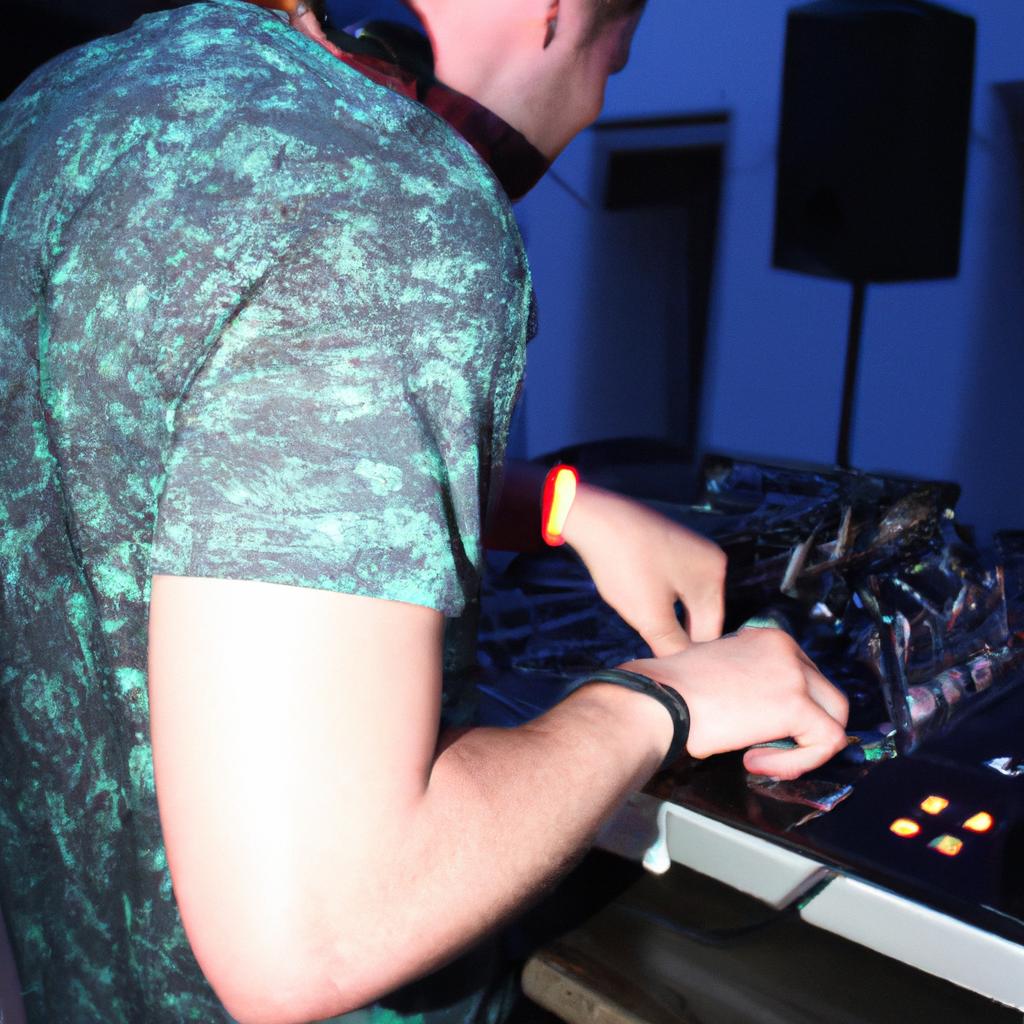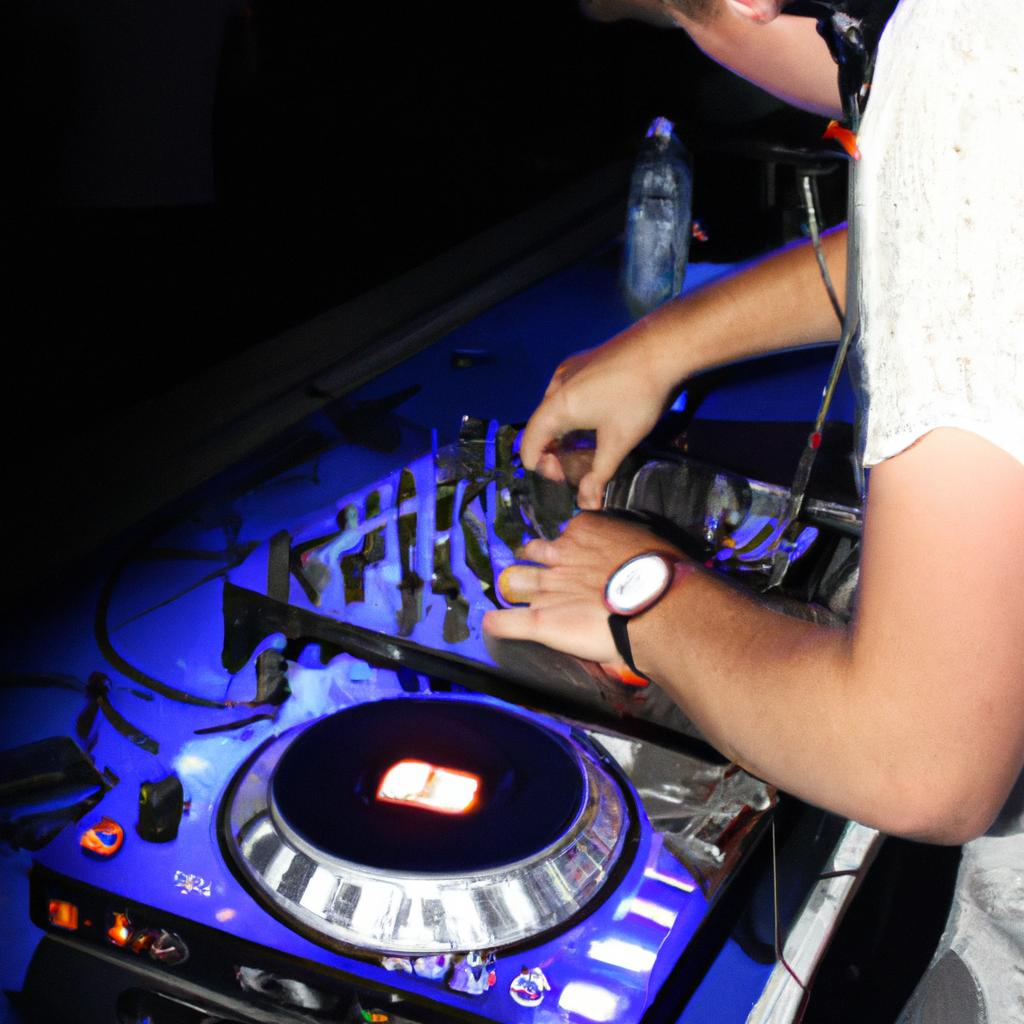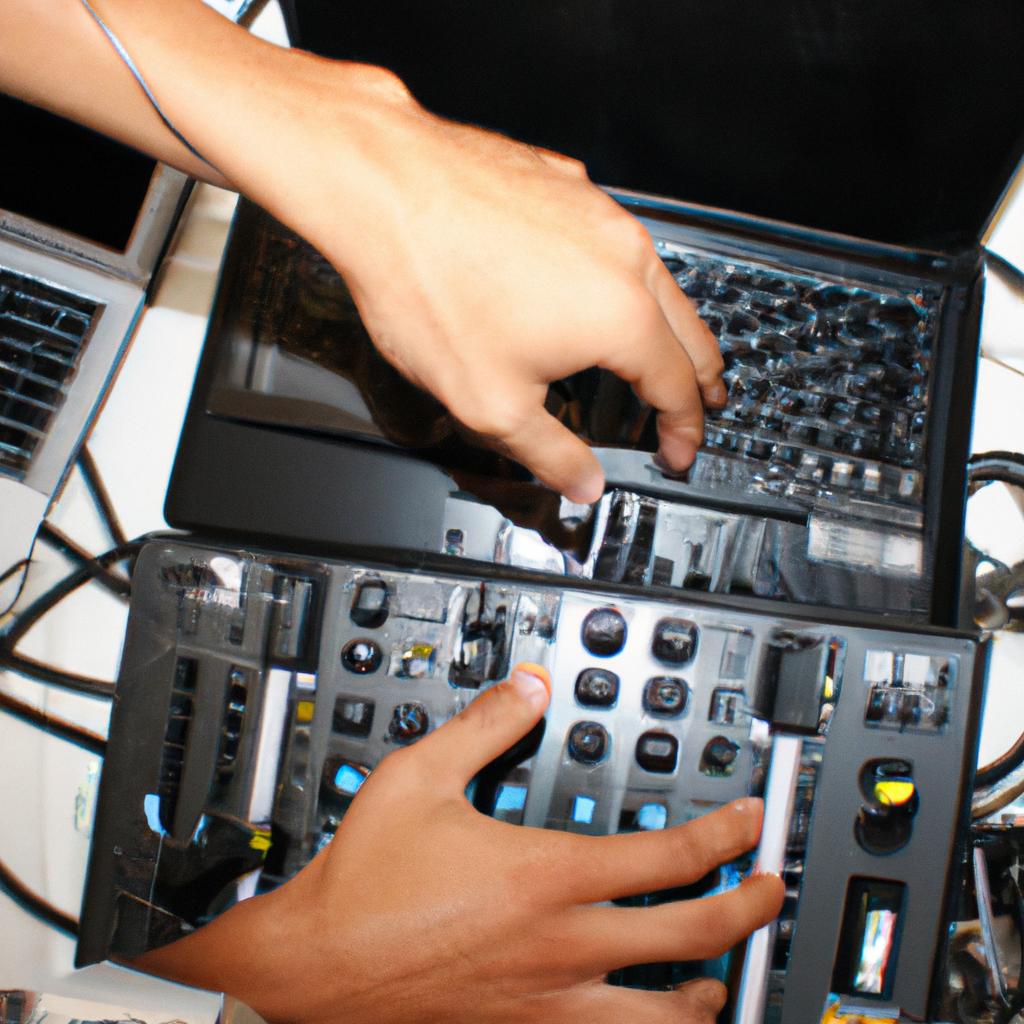DJ Mixing Techniques: Dance & Nightclub DJ Performances
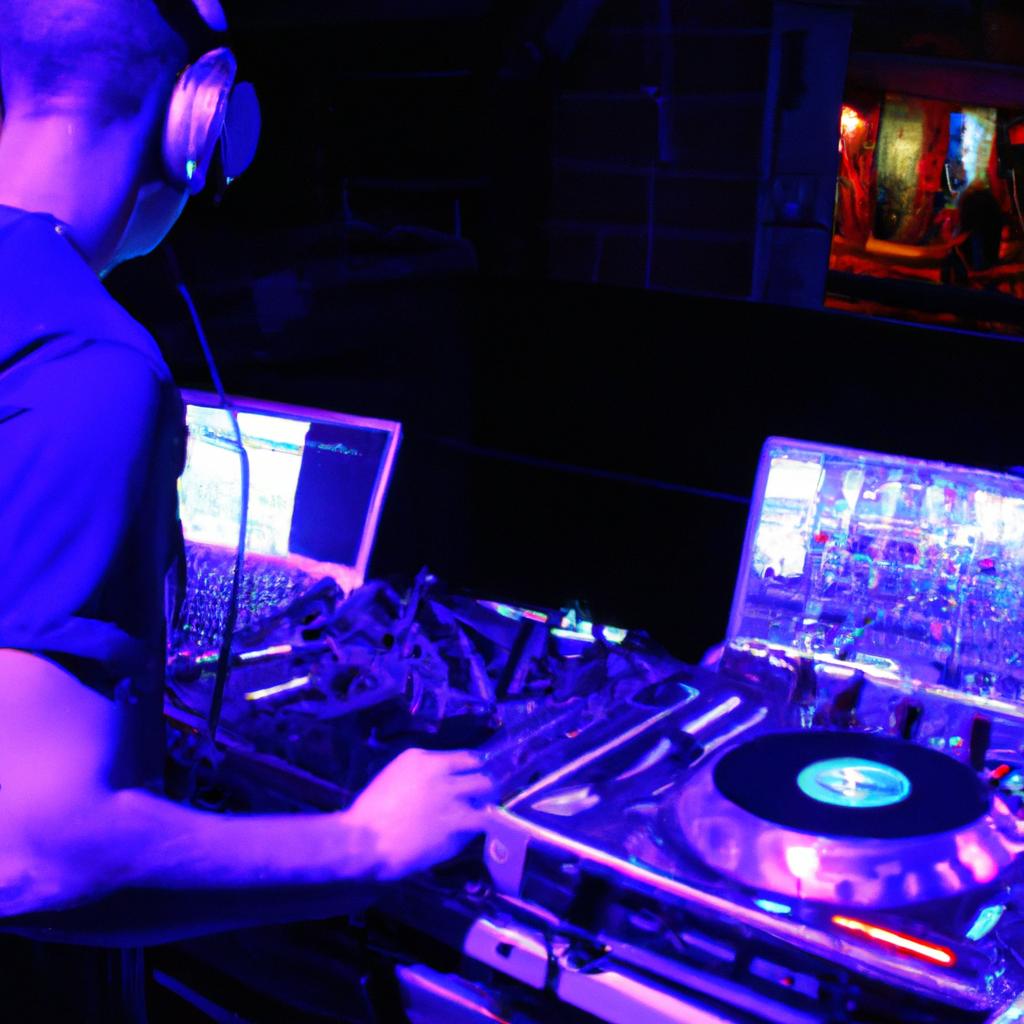
In the world of electronic dance music (EDM) and nightclub culture, DJ mixing techniques play a pivotal role in creating an immersive and electrifying experience for audiences. The art of seamlessly blending tracks together, manipulating beats, and controlling the energy on the dancefloor has become synonymous with skilled DJs who command the decks. For instance, imagine a hypothetical scenario where renowned DJ X is performing at a popular nightclub. With their expert knowledge of mixing techniques, DJ X effortlessly transitions between various genres, tempos, and moods, captivating the crowd from start to finish.
The mastery of DJ mixing techniques involves more than simply playing one song after another; it requires careful consideration of key elements such as beatmatching, phrasing, equalization, and effects manipulation. Beatmatching refers to synchronizing the tempo and rhythm of two or more tracks so that they blend harmoniously without any discernible gaps or inconsistencies. This technique ensures a seamless flow throughout the set and maintains a continuous groove that keeps dancers engaged on the dancefloor. Additionally, understanding musical phrasing allows DJs to create dynamic transitions by identifying natural breaks within songs that can be used to smoothly mix into the next track. By utilizing EQ controls effectively, DJs can adjust frequencies – such as basslines or vocals – to enhance or diminish their presence in the mix, creating a balanced and well-rounded sound. This allows DJs to highlight certain elements of a track, create smooth transitions between songs, and maintain clarity in the overall mix.
Furthermore, effects manipulation is another crucial aspect of DJ mixing techniques. Effects such as reverb, delay, filters, and flangers can be applied to individual tracks or the entire mix to add depth, texture, and excitement. DJs can use effects creatively to build tension, add impact during drops or breakdowns, or create unique sonic landscapes that elevate the energy on the dancefloor.
In addition to these technical skills, a skilled DJ also possesses a deep knowledge of music genres and an ability to read the crowd’s energy and preferences. By understanding different musical styles and knowing how they complement each other, DJs can create diverse and captivating sets that cater to a wide range of tastes. They are also adept at adjusting their song selection on-the-fly based on audience response, ensuring that the energy remains high throughout the night.
Overall, mastering DJ mixing techniques requires a combination of technical proficiency, creativity, musical knowledge, and intuition. Through practice and experience, DJs develop their own unique style and signature sound that sets them apart from others in this dynamic and ever-evolving field.
Beatmatching
Beatmatching is a fundamental skill in DJ mixing that involves aligning the beats of two or more tracks to create a seamless transition between songs. By synchronizing the tempos and matching the beats, DJs can maintain a consistent energy level on the dancefloor, keeping the crowd engaged and moving.
To illustrate its importance, let’s consider a hypothetical scenario: imagine being at a nightclub where the DJ fails to properly beatmatch. The first track ends abruptly, leaving an awkward silence before the next song starts with an abrupt change in tempo. This jarring transition disrupts the flow of music and interrupts the dancers’ rhythm, resulting in a disengaged audience.
To avoid such mishaps, DJs employ various techniques for beatmatching. One common approach is manually adjusting the pitch control on their equipment to match the tempos of two tracks. Additionally, they may use headphones to preview upcoming songs while simultaneously playing another track through speakers. This allows them to listen for similar phrasing and rhythmic patterns, making it easier to blend together seamlessly.
In mastering this skillset, DJs benefit from understanding certain key principles:
- Timing: Precise timing is crucial when beatmatching. It requires careful attention to detail as even slight deviations can affect how well two tracks sync up.
- Ear Training: Developing a keen sense of hearing helps DJs detect subtle differences in tempo and adjust accordingly.
- Practice: Consistent practice is essential for honing beatmatching skills. Regularly experimenting with different genres and BPM ranges helps expand one’s repertoire.
- Technology: Utilizing modern DJ software or hardware can aid in automating beatmatching processes but should not replace manual techniques entirely.
| Beatmatching Benefits | |
|---|---|
| Seamless transitions | Keeps dancers engaged |
| Maintains energy levels | Enhances overall musical experience |
In conclusion, beatmatching plays a vital role in creating smooth transitions during DJ performances by aligning track tempos and beats. Through precise timing, ear training, regular practice, and the effective use of technology, DJs can seamlessly blend tracks together, ensuring a captivating dancefloor experience.
[Transition to Phrasing Section] When considering seamless transitions between songs, it is essential for DJs to understand the concept of phrasing and how it complements beatmatching techniques.
Phrasing
Transition from the Previous Section: Beatmatching
Having explored the art of beatmatching in the previous section, we now turn our attention to another important aspect of DJ mixing techniques: phrasing. Just as beatmatching ensures a seamless transition between two tracks, understanding and utilizing proper phrasing enhances the overall flow and energy of a dance or nightclub DJ performance.
Phrasing: Enhancing Musical Continuity
Phrasing refers to organizing musical elements such as melodies, rhythms, and vocal hooks into coherent sections within a track or mix. By carefully selecting and blending tracks based on their phrasing, DJs can create smooth transitions that maintain momentum on the dancefloor. For instance, let’s consider an example where two tracks with different tempos are being mixed together. Through careful manipulation of EQs and filters (which we will explore in detail later), the DJ gradually blends out one track while simultaneously introducing the next track at an appropriate point in its phrase structure. This creates a harmonious progression that keeps dancers engaged without disrupting their groove.
To better understand how phrasing affects a DJ set, here are some key considerations:
- Energy management: Properly aligning the energetic peaks and valleys of tracks allows for dynamic control over crowd reaction.
- Building tension: Utilizing longer phrases or breakdowns before dropping into high-energy sections can heighten anticipation among listeners.
- Creating contrast: Playing contrasting elements across various tracks’ phrases adds depth to the set and prevents monotony.
- Maintaining continuity: Ensuring that adjacent phrases connect smoothly by matching harmonic content aids in creating cohesive mixes.
To illustrate these concepts further, refer to the following table showcasing how different styles of music may vary in terms of typical phrase lengths:
| Music Genre | Typical Phrase Length |
|---|---|
| House | 16 bars |
| Techno | 32 bars |
| Hip-hop | 8 bars |
| Drum and Bass | 64 bars |
Understanding the unique phrasing characteristics of different genres allows DJs to tailor their mixing techniques accordingly, creating a more engaging experience for their audience.
Moving Forward: EQ Mixing
By mastering the art of phrasing, DJs can elevate their sets to new heights. However, effective DJ mixing encompasses various other components beyond beatmatching and phrasing.
EQ Mixing
Transitioning seamlessly between songs is a crucial skill for DJs, and it can greatly enhance the energy and flow of a dance or nightclub performance. In this section, we will explore the concept of EQ mixing, which involves adjusting the equalization settings of different tracks to create smooth transitions.
Imagine you are DJing at a popular nightclub on a Saturday night. The crowd is fully immersed in the music, dancing euphorically to your beats. As one track reaches its climax, you want to smoothly transition into another that complements both the mood and energy level of the room. This is where EQ mixing comes into play.
EQ mixing refers to manipulating the frequency range of individual tracks to blend them together harmoniously. By adjusting the bass, midrange, and treble frequencies using an equalizer, DJs can ensure that there are no abrupt changes in sound when transitioning from one song to another. For example, let’s say you have two tracks with similar BPMs (beats per minute) but slightly different tonal qualities. By reducing the bass frequencies on Track A while gradually increasing them on Track B during the transition, you can create a seamless mix that maintains continuity and keeps the dancefloor grooving.
To successfully execute EQ mixing techniques, here are some key considerations:
- Pay attention to each track’s spectral content: Understanding how specific instruments or sounds occupy different frequency ranges can help you make informed decisions about EQ adjustments.
- Use gradual adjustments: Abrupt changes in EQ settings can disrupt the flow of a mix; instead, aim for subtle alterations over time.
- Be mindful of clashing frequencies: Certain elements within tracks may clash when played simultaneously due to overlapping frequency ranges. Skillful use of EQ can mitigate conflicts and preserve sonic clarity.
- Experiment with creative applications: While maintaining harmonic compatibility is important, don’t be afraid to experiment with unconventional EQ choices if they add excitement or surprise to your mixes.
By mastering these techniques, DJs can elevate their performances to new heights and create a seamless sonic journey for their audience.
Transition Techniques
Transitioning seamlessly between tracks is a fundamental skill for any DJ. Let’s explore some of these techniques and how they contribute to creating an electrifying atmosphere on the dance floor.
One example of a transition technique commonly used by DJs is known as “the drop mix.” In this technique, the DJ builds anticipation among the audience by gradually reducing the volume of one track while simultaneously increasing the volume of another. This creates tension and excitement, leading up to a climactic moment when both tracks play together at full volume – resulting in an explosive transition that energizes the crowd.
To further enhance transitions, DJs often utilize additional effects such as echo or reverb. These effects can be applied during key moments within a mix, adding depth and intensity to certain elements of a track. By manipulating these effects in sync with the beats and melodies, DJs create dynamic soundscapes that captivate listeners and keep them engaged throughout their set.
To help illustrate different transition techniques, here are four bullet points outlining some popular methods employed by skilled DJs:
- The Breakdown Build: Gradually decreasing energy levels before introducing a new track with a powerful build-up.
- The Loop Mix: Using loops from one track to blend smoothly into another, creating seamless transitions without disrupting the flow.
- The Acapella Overlay: Layering vocals from an acapella over an instrumental track, allowing for creative mashups and unexpected combinations.
- The Filter Fade: Applying high-pass or low-pass filters to gradually remove specific frequencies from one track while bringing in another, resulting in smooth tonal shifts.
In addition to using various techniques, it is essential for DJs to have awareness of musical keys and tempos when transitioning between tracks. A well-chosen pairing can elevate a performance by maintaining harmonic coherence and rhythmic cohesion. By understanding how different tracks can complement each other sonically, DJs can create a seamless and enjoyable listening experience for their audience.
Transitioning smoothly between tracks is just one aspect of DJ mixing. In the subsequent section on “Creative Mixing,” we will explore how DJs go beyond traditional transitions to incorporate innovative techniques that push boundaries and ignite creativity in their performances. By employing these methods, DJs are able to showcase their unique style and take their audiences on unforgettable musical journeys.
Creative Mixing
Transitioning smoothly between songs is a crucial skill for any dance or nightclub DJ. In the previous section, we explored various transition techniques that can be employed to keep the energy flowing on the dance floor. Now, let’s delve into the realm of creative mixing, where DJs can showcase their unique style and elevate their performances to new heights.
Imagine you’re at a packed nightclub, surrounded by enthusiastic partygoers eagerly awaiting the next beat drop. The DJ seamlessly blends two tracks together, creating an unexpected yet harmonious fusion of sounds. This creative mixing technique not only keeps the crowd engaged but also adds an element of surprise and excitement to the overall experience.
To spice up your mixes and captivate your audience, consider incorporating these key elements:
- Mashups: Combine different instrumental sections or acapellas from multiple tracks to create a fresh composition that intertwines familiar melodies with innovative beats.
- Looping: Repeat specific segments of a song to build tension and anticipation before unleashing it onto the dance floor in its full glory.
- Effects: Experiment with various audio effects like echo, reverb, or filters to add depth and texture to your mixes.
- Sampling: Borrow snippets of vocals or instrumentals from other tracks to introduce recognizable hooks or motifs that resonate with your audience.
Now let’s explore how these techniques can be applied through a hypothetical case study involving a popular dance track:
| Technique | Example |
|---|---|
| Mashup | Combining vocal samples from one track with the instrumental outro of another track |
| Looping | Repeating a catchy synth riff during the breakdown of a high-energy EDM anthem |
| Effects | Applying a filter sweep effect to gradually alter the timbre of an underlying bassline |
| Sampling | Introducing short snippets of an iconic disco hit within a modern house track |
By embracing these creative mixing techniques, DJs can elevate their performances to a whole new level, leaving the audience craving for more. The key lies in finding the right balance between innovation and familiarity, creating an immersive sonic experience that resonates with everyone on the dance floor.
As we move forward into our next section about “Controllerism,” let’s explore how DJs are utilizing advanced technology to push the boundaries of creativity even further.
Controllerism
Creative Mixing Techniques: Elevating Dance & Nightclub DJ Performances
In the previous section, we explored various creative mixing techniques that DJs can employ to enhance their performances. Now, let’s delve into another aspect of modern DJing known as Controllerism. This innovative approach utilizes specialized controllers and software to manipulate audio in real-time, creating unique and captivating musical experiences.
To illustrate the power of Controllerism, imagine a scenario where a skilled DJ is performing at a popular nightclub. As the night progresses and the energy on the dance floor reaches its peak, the DJ seamlessly transitions from one track to another using a controller loaded with effects. By manipulating parameters such as pitch, filters, and delays on-the-fly, they create an electrifying build-up before unleashing a bass-heavy drop that sends the crowd into frenzy.
Controllerism offers DJs unprecedented control over their mixes, allowing them to push boundaries and experiment with different soundscapes. Here are some key elements that make this technique so exciting:
- Flexibility: Controllers offer immense flexibility by providing access to multiple functions within reach. DJs can trigger loops, samples, or even entire songs effortlessly during their performance.
- Precision: The use of precise jog wheels allows for seamless beat matching and synchronization between tracks. This ensures smooth transitions throughout the set.
- Customization: Many controllers allow DJs to customize their setup according to their preferences. From assigning specific buttons for effect triggers to mapping controls for specific software features – personalized setups enable artists to develop their unique style.
- Visual Feedback: Most controllers come equipped with LED screens or visual cues that display essential information like track waveforms, BPM (beats per minute), and cue points. This visual feedback aids in accurate timing and helps DJs stay connected with their music.
Table 1 below provides an overview of commonly used DJ controllers alongside their standout features:
| Controller | Standout Features |
|---|---|
| Pioneer DDJ-1000 | Full-sized jog wheels with LCD screens |
| Native Instruments Traktor Kontrol S4 MK3 | Haptic drive technology for enhanced touch response |
| Numark NS7III | Motorized platters for vinyl-like feel |
| Novation Launchpad Pro MK3 | Grid-based controller for intuitive performance |
As the DJ industry continues to evolve, Controllerism has emerged as a powerful tool that empowers DJs to push their artistic boundaries. By harnessing the flexibility and precision of controllers, performers can create unforgettable experiences on dance floors around the world.
Incorporating Controllerism into your DJ sets opens up endless possibilities for creativity and musical expression. Whether you’re a seasoned professional or just starting out, embracing this technique will undoubtedly elevate your performances and leave a lasting impact on audiences everywhere.



